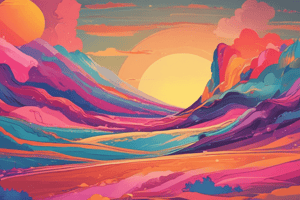Podcast
Questions and Answers
What does value in art primarily refer to?
What does value in art primarily refer to?
- The relative lightness or darkness of an image. (correct)
- The arrangement of elements in space.
- The vibrancy of colors in a composition.
- The tactile quality of materials.
Which statement accurately describes texture in art?
Which statement accurately describes texture in art?
- Texture is irrelevant in visual art.
- Texture cannot be implied and must be physically present.
- Texture refers only to the color quality of materials used.
- Texture can be both inherent and created through surface manipulation. (correct)
What is meant by positive space in a work of art?
What is meant by positive space in a work of art?
- The emotional impact of the color used.
- The area usually occupied by the subject of the painting. (correct)
- The background area surrounding the artwork.
- The empty areas that enhance the subject.
How is motion depicted in art according to the concepts outlined?
How is motion depicted in art according to the concepts outlined?
What is color theory primarily concerned with?
What is color theory primarily concerned with?
How do value and color differ in their definitions related to art?
How do value and color differ in their definitions related to art?
What best describes the role of texture in art?
What best describes the role of texture in art?
How is space differentiated in a work of art?
How is space differentiated in a work of art?
What does the concept of time imply in relation to motion in art?
What does the concept of time imply in relation to motion in art?
Which statement about color theory is true?
Which statement about color theory is true?
Flashcards are hidden until you start studying
Study Notes
Value
- Describes the relative lightness or darkness in an image.
- Refers to the spectrum of grays that exist between black and white.
- Essential for artists to create depth and contrast in their work.
Color
- One of the most difficult elements of art to define.
- Perception of color is based on human interpretation, using descriptive words like red, blue, and yellow.
- Color theory categorizes and explains the qualities, behaviors, and effects of color for visual artists.
Texture
- Refers to the surface characteristics of materials perceived through touch and sight.
- Can be inherent in the artist's materials or created through surface manipulation.
- Also achieved through illusionistic rendering, mimicking textures such as smooth silk or rough tree bark.
Space
- Describes the area around or within the elements of a work of art, termed by Frank Lloyd Wright as "the breath of art."
- Artists manipulate space using lines, shapes, forms, and colors.
- Involves two types:
- Positive space - the area occupied by the subject.
- Negative space - the area surrounding or between subjects.
Time and Motion
- Crucial elements in art that involve change and movement.
- Motion can occur over time and distance, contributing to the artwork's dynamic quality.
- Kinetic art incorporates actual movement, while implied motion creates the illusion of movement within a static piece.
Value
- Describes the relative lightness or darkness in an image.
- Refers to the spectrum of grays that exist between black and white.
- Essential for artists to create depth and contrast in their work.
Color
- One of the most difficult elements of art to define.
- Perception of color is based on human interpretation, using descriptive words like red, blue, and yellow.
- Color theory categorizes and explains the qualities, behaviors, and effects of color for visual artists.
Texture
- Refers to the surface characteristics of materials perceived through touch and sight.
- Can be inherent in the artist's materials or created through surface manipulation.
- Also achieved through illusionistic rendering, mimicking textures such as smooth silk or rough tree bark.
Space
- Describes the area around or within the elements of a work of art, termed by Frank Lloyd Wright as "the breath of art."
- Artists manipulate space using lines, shapes, forms, and colors.
- Involves two types:
- Positive space - the area occupied by the subject.
- Negative space - the area surrounding or between subjects.
Time and Motion
- Crucial elements in art that involve change and movement.
- Motion can occur over time and distance, contributing to the artwork's dynamic quality.
- Kinetic art incorporates actual movement, while implied motion creates the illusion of movement within a static piece.
Studying That Suits You
Use AI to generate personalized quizzes and flashcards to suit your learning preferences.



